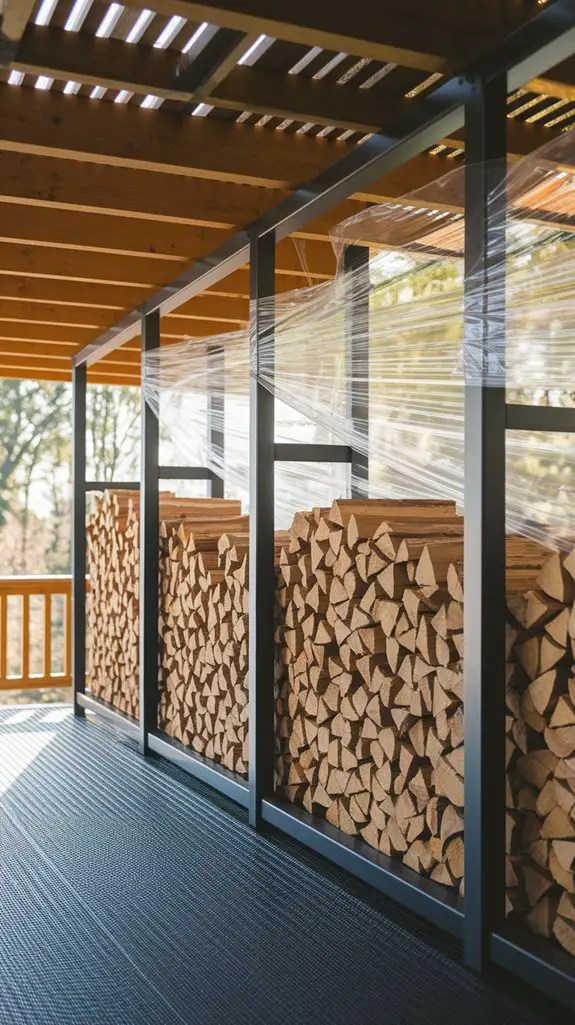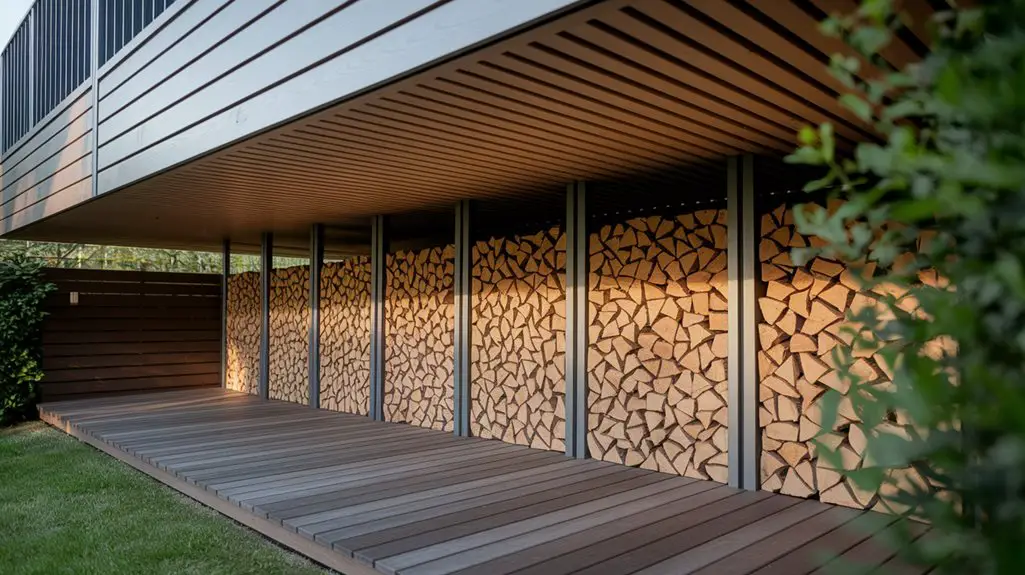The silent space beneath your deck harbors untapped potential, like a forgotten vault waiting to be claimed. You’ll find that transforming this area into a firewood storage solution requires careful planning and technical consideration. Smart under-deck systems balance moisture control with accessibility, ensuring your fuel stays dry while remaining within easy reach. Proper framework design and seasonal adaptations make the difference between soggy, unusable logs and a reliable heat source throughout winter’s coldest moments.
Designing the Ideal Under-Deck Framework for Firewood
When considering the structural integrity of your under-deck storage system, proper framework design becomes the critical foundation for successful firewood storage.
Begin by calculating load capacity—seasoned firewood weighs approximately 80-150 pounds per cubic foot, depending on wood species.
Construct a base frame using pressure-treated 2×4 lumber for ground contact, ensuring 6-inch clearance above soil to prevent moisture wicking.
Install vertical supports every 24 inches, anchored with concrete footings below the frost line if your climate demands it.
Incorporate cross-bracing to prevent lateral movement, and slope the floor at a 2-degree angle to facilitate drainage.
Add a vapor barrier beneath the structure to block ground moisture.
For accessibility, design the front with removable slat panels or a hinged door system that allows air circulation while maintaining easy access.
Moisture Control Techniques for Below-Deck Storage

Effective moisture control represents the logical extension of a well-designed framework, as even the sturdiest under-deck structures will fail to protect firewood without proper humidity management.
You’ll need a multi-layered approach to combat dampness.
First, install vapor barriers along the ground using 6-mil polyethylene sheeting with 12-inch overlaps at seams. Secure edges with pressure-treated lumber to prevent shifting.
Next, incorporate cross-ventilation by installing offset lattice panels that permit airflow while blocking precipitation.
For the storage platform, elevate wood stacks 6-8 inches above ground using pallets or pressure-treated 2×4 stringers.
Consider installing small-diameter drainage pipes beneath your structure, positioned at a 2% grade to channel water away from stored firewood.
During extended rainy periods, temporary tarps with grommets can provide supplemental protection without trapping condensation. Additionally, remember that proper firewood storage techniques can significantly enhance the longevity and usability of your firewood.
Maximizing Storage Capacity in Limited Under-Deck Spaces

Three key constraints define under-deck storage maximization: vertical clearance, horizontal footprint, and accessibility.
You’ll need to adopt strategic approaches that optimize these dimensions while maintaining firewood quality.
Consider these space-maximizing techniques:
- Vertical stacking systems – Install adjustable metal racks that utilize the full height clearance with proper weight distribution.
- Modular storage cubes – Implement customizable storage units that conform to irregular perimeter spaces.
- Rolling carts – Deploy wheeled platforms for areas with limited access points, enabling rotation of seasoned wood.
- Tiered shelving – Create multi-level storage with the driest wood positioned on upper shelves away from ground moisture.
Additionally, ensure that your firewood is stored in a way that promotes proper airflow to prevent moisture buildup and maintain its quality.
Measure your available space carefully before purchasing or constructing storage solutions, accounting for proper airflow gaps between wood and structural elements.
Accessibility Features for Easy Firewood Retrieval
While designing your under-deck storage area, accessibility remains paramount for efficient firewood retrieval during harsh weather conditions or after dark.
Install motion-activated lighting to illuminate the storage area when you approach. Position these lights strategically to eliminate shadows that might obscure wood selection.
Incorporate sliding racks or pull-out drawers mounted on heavy-duty rails for effortless access to wood stored in deeper sections.
Consider implementing a first-in, first-out (FIFO) system using sloped shelving that allows logs to roll forward as you remove front pieces.
For vertical stacks, install removable dividers every 16-24 inches to prevent avalanche collapses when retrieving logs.
Add a small weatherproof container nearby to store kindling, fire starters, and tools for immediate convenience during retrieval operations. Additionally, ensure that your storage area is designed to withstand the elements, as backyard storage for pool supplies can help inform effective protection strategies.
Combining Aesthetics With Functionality in Hidden Storage
Although practicality drives most under-deck storage designs, your firewood storage can seamlessly integrate with your outdoor aesthetic through thoughtful concealment methods.
Consider implementing sliding panels or hinged doors that match your existing deck materials to create a cohesive look while maintaining functionality.
- Install cedar lattice screens with climbing plants to create a living wall that disguises your woodpile while providing proper ventilation.
- Mount custom-sized rolling barn doors on tracks to allow full access while adding architectural interest.
- Construct pull-out drawer systems with decorative fronts that mirror your home’s exterior finishes.
- Incorporate ambient lighting around access points to transform utilitarian storage into an architectural feature.
These techniques effectively balance visual appeal with the practical requirements of firewood storage, ensuring your solution enhances rather than detracts from your outdoor living space. Additionally, using creative DIY firewood rack designs can further elevate your backyard’s style while providing efficient storage options.
Seasonal Considerations for Under-Deck Wood Protection
As seasons shift throughout the year, your under-deck firewood storage requires specific protective measures to maintain wood quality and structural integrity. Monitor moisture levels closely, as wet wood becomes susceptible to decay and attracts pests that can damage your deck’s foundation.
| Season | Primary Threat | Protective Measure |
|---|---|---|
| Spring | Rainfall | Elevated platforms with drainage slots |
| Summer | Insects | Cedar lining and natural repellents |
| Winter | Snow buildup | Waterproof covering and air circulation |
Install adjustable ventilation panels that you can modify based on humidity levels. During humid months, increase airflow to prevent mold growth; in drier periods, restrict airflow to maintain ideal moisture content. Consider applying wood preservatives specifically formulated for outdoor storage to extend your firewood’s usability and protect your investment year-round.
Conclusion
By implementing these smart under-deck storage solutions, you’ll transform wasted space into a functional firewood repository. Your methodical approach to framework construction, moisture control, and accessibility features guarantees ideal wood preservation while maintaining aesthetic appeal. Remember, measure twice, cut once—this principle applies not just to construction but to your entire storage system design. Seasonal adjustments complete your technical solution, providing year-round protection against environmental variables.




